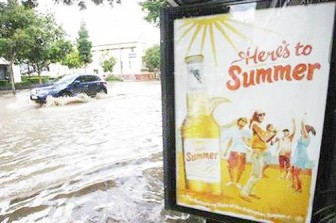BRISBANE, Australia, (Reuters) – Thousands of residents of Australia’s third-largest city evacuated homes yesterday as massive floods threatened to inundate the financial district, sparked panic buying of food and left authorities despairing for more than 90 people missing.
The biggest floods in decades have so far killed 14 people since starting their devastating march across the northern mining state of Queensland last month, crippling the coking coal industry, destroying infrastructure, putting a brake on the economy and sending the local currency to four-week lows.
With a flood surge expected to peak in the Queensland capital of Brisbane, a city of two million, tomorrow, search and rescue crews took advantage of rare sunshine yesterday to look for those still missing from tsunami-like flash floods that tore through townships west of the city this week.
“I think we’re all going to be shocked by what they find in these towns that were hit by that tsunami yesterday,” Queensland state Premier Anna Bligh told local television yesterday.

The worsening floods are forcing economists to raise estimates of the economic impact, with one central bank board member quoted yesterday as saying the disaster could cost as much as 1 percent of economic growth — equal to almost $13 billion, double the previous highest estimate.
The Australian dollar sank to a fresh four-week low of $0.9803 on the comments from Warwick McKibbin, an academic and a member of the central bank’s policy making board.
In Brisbane, thousands of homes and businesses were inundated as swirling flood waters rose in and around the riverside city, triggering residents to flee with few possessions to higher ground and evacuation centres.
City Mayor Campbell Newman said the number of homes expected to be hit by flooding had risen to 19,700, affecting up to 45,000 people, with the military now running relief flights with helicopters and C-130 transports.
Dams built to protect communities are at bursting point.
Power company Energex has shut power to some low-lying areas of Brisbane, including parts of the financial district, for fear that live power lines could electrify floodwaters. Up to 100,000 homes in Brisbane and nearby Ipswich were without electricity.
Bligh said the Brisbane River, which winds through the city centre, should peak at the high tide tomorrow around mid-afternoon, with thousands of properties to be inundated before that time, but she appealed for calm.
“Right across this region, this river is creating chaos, terrifying people and causing damage already,” she said.
Unmoored boats and pontoons with speedboats still attached could be seen adrift on the Brisbane River, which was swirling with flotsam as the sun broke through on Wednesday for what was expected, allowing rescue helicopters into the air.
Showers, though, were forecast to return next week.
Some scenes in the city were surreal with early-morning joggers trying to carry on as normal, despite parts of the their routes being submerged.
Amy Cotterill, a waitress at a central Brisbane cafe, said she was unsure about the fate of the city, with flood levels of around 4.5 metres expected on Wednesday and worse to come.
“They make it sound like it’s going to be bad, cutting power and so on,” she said, adding that so far her home in the Hawthorn area of the city was on dry ground.
Hundreds of people were evacuated overnight from homes at Ipswich, west of Brisbane, with a third of the town expected to go under water as the Bremer River peaks.
Further south, in neighbouring New South Wales state, entire communities were evacuated around Grafton and Maclean, as the Clarence River swelled, catching emergency teams by surprise.
In southeast Victoria state, heavy rain caused flash flooding around the town of Horsham, prompting fears a nearby lake could break its banks, while in Western Australia authorities fought bushfires in a summer of extremes. Thin lines of sandbags surrounded some businesses in downtown Brisbane, with some motorists braving flooded streets.
“There is nothing we can do about it,” said Ricardo Rindu, who runs a Latin Restaurant on Melbourne Street. “I tried ringing the council for sandbags but there was no answer.”
Floodwaters entered the lobby of Brisbane’s Cutting Edge TV production house. A day earlier workers had tried desperately to sandbag the glass-front building full of high-tech equipment.
Some residents wheeled shopping carts and carried bags laden with food as supermarkets ran out of staples such as milk and bread. Food prices are surging around the country as the floods ruin crops in Queensland and sever distribution networks.
Police were starting to close off more streets in the centre of Brisbane as some streets were flooded with knee-high water.
Shocked PM visits flooded city
Prime Minister Julia Gillard arrived in the city to inspect the devastation and said she was deeply concerned about the impact of the flood on jobs and livelihoods.
“I have been shocked. I think we’ve all been shocked by the images of that wall of water just wreaking such devastation. The dimensions of it are truly mind-boggling,” Gillard said.
“We will have to work through the long-term economic impacts for Queensland, and of course the huge infrastructure re-building task to come as floodwaters subside.”


